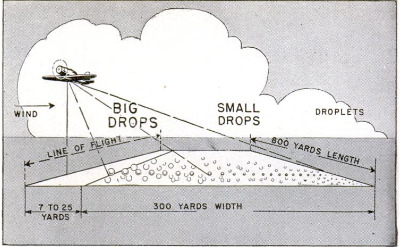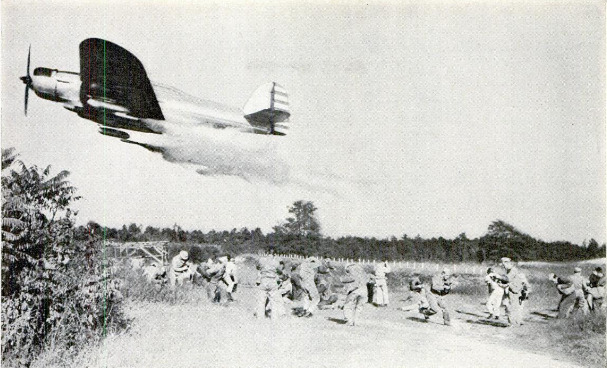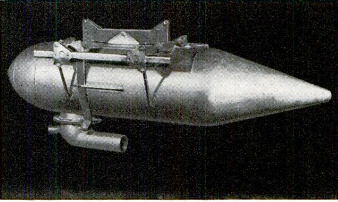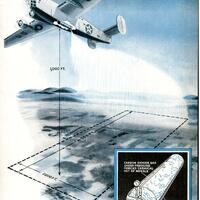-
Title (Dublin Core)
-
Gas attacks from the air
-
Article Title and/or Image Caption (Dublin Core)
-
Title: Gas attacks from the air
-
extracted text (Extract Text)
-
WHEN the almost incredible striking
power of air chemical warfare is re-
vealed, the world will be as sur-
prised as it was by the success of the first
German mass attacks by tanks and mech-
anized troops supported by airplanes. Chem-
icals could be used from the air on a
tremendous scale—not by single flights or
squadrons of aircraft, but by massed squad-
rons of planes dropping gas in overwhelm-
ing quantities.
There is no doubt that the airplane pro-
vides the best method of disseminating cer-
tain types of gases, and I am confident that
large-scale dispersion of mustard, or the
other powerful blister gas, lewisite, would
cause a complete revision of our present
ideas of how to wage war. Despite treaties
and international agreements, no nation has
abandoned the chemical weapon.
The problem of protection against gas is
tremendously complicated by the airplane,
and the country must recognize and prepare
for the added burdens which air chemical
warfare might put upon it. During the first
World War chemicals were not used from
the air; gas was dispersed entirely by
ground weapons, and never penetrated more
than ten or 12 miles behind the front lines.
Today the wide radius of action of aircraft
and the development of effective means of
projecting gas from airplanes radically
change the entire aspect of chemical warfare.
‘There will no longer be any areas in which
anti-gas measures are unnecessary; any-
where that a bomber can reach there may
be danger of gas. Industrial and transpor-
tation centers far behind the actual combat
zones, as well as communication lines, troop
concentrations, food and ammunition dumps,
and all military installations, may be sub-
ject to attack; and at all points within range
of enemy aircratt protective equipment will
be maintained ready for instant use.
When the words “chemical warfare” are
mentioned, most people immediately think,
“poison gas.” Although this term is widely
used, it is really a misnomer, for most of
the chemical combat substances are liquids
and solids. They are roughly classified by
American military authorities as “persist-
ent” and “nonpersistent.” If no protection is
needed after ten minutes, as is generally the
case with phosgene, chlorine, and other
highly volatile gases which vaporize entirely
at the moment of release, they are non-
persistent. If the amount effective after ten
minutes is enough to make a man put on his
gas mask, the substance is said to be per-
sistent.
Some of the liquids which will be used in
future air chemical warfare are remarkably
persistent. Mustard gas,
still regarded as probably
the most effective casualty-
producing gas yet developed,
remains effective on the
ground in the summer from
a day to a week or more,
and in cold weather it may
persist for several weeks.
Throughout that time it is
a constant danger.
Persistent chemicals may
be used from the air in sev-
eral ways. They may be re-
leased from tanks carried in
the bomb racks and under
the wings of airplanes, or
placed upon an enemy area
by means of chemical bombs,
which are simply dropped
and explode either in the air
or upon contact. Two types
of tanks are in use the
sprinkler, from which the
and the spray type, from which the chemical
runs out in a stream and is broken up by
the air stream of the fast-moving airplane.
It falls upon the target in the form of an
enveloping spray or mist.
When the sprinkler type is employed in an
attack, the liquid is forced backward out of
the tank by a propellant, usually carbon
dioxide gas, at a speed roughly equal to the
air speed of the plane. This makes it fall
straight down in large drops about the size
of rain drops, and little vaporization occurs
until it hits the ground.
The principal disadvantage of the sprin-
kler method of disseminating gas from air-
planes lies in the fact that it is difficult to
predict where the drops will fall, for the fall
depends upon the speed and direction of the
wind at various levels. Under favorable air
conditions at night it should be possible to
hit a target such as a large industrial dis-
trict from altitudes up to 10,000 feet. At
altitudes of 2,000 feet it will not be difficult
to hit a small area such as a railway termi-
nal or junction.
It is estimated that from 1,000 feet with
an average wind velocity of 30 miles an
hour, an area 1,000 feet wide by 4,000 feet
long can be covered by about 700 pounds of
chemicals by sprinkling. The width of the
area covered increases with the altitude
from which the liquid is dropped, and also
with the wind velocity. The greater the area
covered, however, the less concentration on
the ground.
The sprinkler-type tank is comparatively
heavy and cumbersome; is suitable only for
medium and heavy bombers. On the other
hand, the spray-type apparatus, which is
the standard means of dispersing chemicals
from the air and is the most effective means
of chemical warfare, is simple and light.
Equipment for a light bomber consists of
four streamlined tanks, each holding about
22 gallons and weighing approximately 50
pounds empty, fastened to racks underneath
the wing. When the discharge line is oper-
ated in flight by electrical means controlled
by the pilot, the chemical runs out of the
tank and is broken by the air blast into a
finely atomized cloud of droplets, which fall
to the ground forming a rectangular pat-
tern. The larger drops fall almost under-
neath the plane, while the small ones are
carried farther down-wind. The length of
the pattern is the distance that the airplane
has traveled during the time the tank was
being emptied. The higher the airplane and
faster the wind, the wider the pattern. A
wind at right angles to the line of flight
gives a wider pattern than a parallel wind.
The British believe, according to one of
their official gas-defense publications, that
“spray attacks from a height may be de-
livered by the enemy at such a distance from
the target that the aircraft concerned can
neither be seen nor heard.” There is no
doubt that chemical spray is a practicable
and powerful weapon at high altitudes. But
it was developed primarily for low-altitude
attack, and is most effective at from 75 to
150 feet.
At these altitudes, with a wind speed of
from five to 15 miles an hour, an area about
half a mile long by about a quarter mile
wide may be covered by one of the four
tanks. One airplane, releasing two tanks at
a time, generally covers about a mile. The
entire area thus covered is contaminated by
vapor and droplets of
chemical. Since the agent
has been finely atomized,
evaporation is rapid by
this method, and the im-
mediate concentration of
gas in the air is high. The concentration of
mustard vapor obtained by spraying, for
example, is greater than that obtained by
any other weapon, the effects are produced
more quickly, and the toxic possibilities of
the agent are more completely realized. The
vapor at the time of spraying and for some
time afterwards will affect all personnel in
the area actually contaminated, and even
for a distance down-wind at least equal to
the width of the area sprayed.
The persistence of gas thus discharged
upon an area, however, is much less than
that of the same gas disseminated by means
of the airplane bomb. Where contamination
for long periods with mustard-type agents
is required, the chemical bomb dropped from
planes will be found more useful than the
spray. Three such weapons are now avail-
able to the United States Army—the 30-
pound standard bomb, the 30-pound thin-
case bomb, and the 100-pound thin-case
bomb.
In searching for a more effective bomb, it
was found that a tin can filled with mustard
gas, and dropped from low altitudes at high
speed, gave excellent dispersion of the liquid
mustard. Such a device, however, had a
number of faults and there has been de-
veloped the thin-case bomb, nearly 80 per-
cent of which is active chemical. When
dropped from high altitudes a bursting
charge fired by an instantaneous impact
fuse is used to prevent the bomb burying
itself in the ground and so losing much of
the mustard. When dropped from low alti-
tudes on hard ground the bursting charge
is not used, and the dispersion of the gas is
obtained by the thin-case bomb breaking up
on contact with
the earth, If gross contamination is de-
sired in a small area such as a bridge or a
railway junction, the 100-pound thin-case
bomb, which scatters the chemical over a
radius of about 40 yards, may be used.
The Spaniards dropped a few mustard
bombs from airplanes upon the Riff tribes-
men in Morocco in the spring of 1925. There
have been rumors that gas once was used
from the air by the British in Afghanistan,
and by Russian flyers in Turkestan soon
after the first World War, but it has not
been possible to verify either of these in-
stances. The Italians are known to have
used mustard gas from aircraft in the
Ethiopian War in 1936, with great effect.
The purposes of air chemical attack are
to create casualties to hostile personnel; to
contaminate hostile areas, such as air-
dromes and important ground, and deny
their use to the enemy; to contaminate ene-
my material and supplies, such as airplanes,
bombs, ammunition, and food; to threaten
hostile equipment and personnel and thus
delay operations and require the enemy to
carry means for protection and decontami-
nation; or to cause damage by fire.
‘The possibilities of incendiary bombs have
been thoroughly explored during the present
war. Scarcely a bomber takes off today on
a hostile mission without some share of its
load being taken up by incendiaries. The
most widely used of these weapons is the
small magnesium bomb. The Germans have
one weighing 2.2 pounds, their so-called
“electron” bomb, and the British use one
that weighs about four pounds.
The typical small bomb of this type has
a body of magnesium alloy and sufficient
thermite filling to burn intensely and ignite
the magnesium body when fired by a simple
impact fuse. They are generally dropped in
clusters, or within a large bomb case which
opens in mid-air—the famous Molotov bread
basket of the Russians. By this means the
baby bombs are scattered over a wide area.
They burn fiercely, developing a tempera-
ture of approximately 4,000 degrees F., and
will ignite anything combustible with which
they come in contact.
These small incendiaries are much more
efficient for general purposes than the large
oil bombs which have been used in Europe.
The latter contain as much as 16 gallons of
oil and produce a tremendous amount of
heat, but are so large that only a few of
them can be carried. Small oil bombs should
prove more effective, and their use may be
expected.
-
Contributor (Dublin Core)
-
Col. Alden H. Waitt (article writer)
-
Language (Dublin Core)
-
Eng
-
Date Issued (Dublin Core)
-
1942-06
-
pages (Bibliographic Ontology)
-
102-105, 216
-
Rights (Dublin Core)
-
Public domain
-
Archived by (Dublin Core)
-
Sami Akbiyik
 Popular Science Monthly, v. 140, n. 6, 1942
Popular Science Monthly, v. 140, n. 6, 1942








